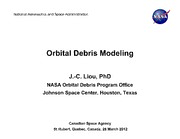
NASA Technical Reports Server (NTRS) 20120003286: Orbital Debris Modeling PDF
Preview NASA Technical Reports Server (NTRS) 20120003286: Orbital Debris Modeling
National Aeronautics and Space Administration OOrrbbiittaall DDeebbrriiss MMooddeelliinngg J.-C. Liou, PhD NNAASSAA OOrrbbiittaall DDeebbrriiss PPrrooggrraamm OOffffiiccee Johnson Space Center, Houston, Texas Canadian Space Agency St Hubert, Quebec, Canada, 28 March 2012 National Aeronautics and Space Administration OOuuttlliinnee • TThhee NNAASSAA OODD EEnnggiinneeeerriinngg MMooddeell – A mathematical model capable of predicting OD impact risks for the ISS and other critical space assets • The NASA OD Evolutionary Model – AA pphhyyssiiccaall mmooddeell ccaappaabbllee ooff pprreeddiiccttiinngg ffuuttuurree ddeebbrriiss environment based on user-specified scenarios • TThhe NNAASSAA SSttanddardd SSattelllliitte BBreakkup MModdell – A model describing the outcome of a satellite breakup ((eexxpplloossiioonn oorr ccoolllliissiioonn)) 2/43 JCL National Aeronautics and Space Administration Orbital Debris Engineering Models 3/43 JCL National Aeronautics and Space Administration WWhhaatt IIss aann EEnnggiinneeeerriinngg MMooddeell?? • An OD engineering model is a mathematical tool – Designed to describe the current and near-future OD flux in the environment – CCreattedd priimariilly ffor spacecrafftt ddesiigners//operattors tto relliiabblly assess spacecraft risk due to OD impacts – Has been used to estimate sensor flux for radar/telescoppe observers • There is a need to update the mode on a regular basis – New data – BBetttter ttechhniiques – Changes in the environment – NNeeeedd ffoorr eexxppaannddeedd ccaappaabbiilliittiieess 4/43 JCL National Aeronautics and Space Administration HHiissttoorryy ooff tthhee NNAASSAA OODD EEnnggiinneeeerriinngg MMooddeellss • Pre-1990 – used a simple flux curve based mostly on model results • 11999944 SSpace SSttattiion FFreeddom moddell andd OORRDDEEMM9966 – obtained Haystack radar data for debris in the 1 cm ttoo 1100 ccmm rreeggiimmee – Used simple equations to describe debris populations in 6 inclination and 2 eccentricity groups • ORDEM2000 – used new techniques and improved ccoommppuutteerr ccaappaabbiilliittiieess ttoo ddeessccrriibbee tthhee LLEEOO environment – Pooppuulaatioonss weeree ddeeriveedd froom ddaataa aandd theen pproocceesssseedd too generate the model environment 5/43 JCL National Aeronautics and Space Administration OORRDDEEMM22000000 DDeebbrriiss EEnnvviirroonnmmeenntt z φφ Vz (km/s) r sin φdθ 20º dr 10º r rdφ 2%1.2% Vy (km/s) 6 7 8 9 1011 r + dr yy θ x • TThhee LLEEOO eennvviirroonnmmeenntt iiss ddeessccrriibbeedd bbyy aa ffiinniittee eelleemmeenntt mmooddeell ((55° × 55° × 5500 kkmm)) with spatial density and velocity distributions of debris of 6 different sizes 6/43 JCL National Aeronautics and Space Administration OORRDDEEMM22000000 GGrraapphhiiccaall UUsseerr IInntteerrffaaccee ((GGUUII)) 7/43 JCL National Aeronautics and Space Administration HHiigghhlliigghhttss ooff tthhee NNeeww MMooddeell –– OORRDDEEMM 33.00 • Expand data sources in time, altitude, and particle size – Altitude: 100 to 40,000 km (LEO through GEO) – LEO-GTO: Use SSN catalog, Haystack, HAX, Goldstone, STS windows/radiators to develop OD populations – GGEEOO:: uussee tthhee MMOODDEESSTT GGEEOO ssuurrvveeyy ddaattaa ttoo ddeevveelloopp ≥≥1100 ccmm ppooppuullaattiioonnss • Utilize higher fidelity supporting environmental models – LEGEND replaces EVOLVE 4.0 – Material density breakdown included – NaK droplet and degradation/ejecta product models added • Use Bayesian statistics to derive debris populations from data – Model uncertainties are included in the output • Maintain two analysis modes: spacecraft and telescope/radar – DDeebbrriiss fflluuxxeess tthhrroouugghh ‘iigglloooo’ iinn ppiittcchh, yyaaww, iimmppaacctt vveelloocciittyy eelleemmeennttss ((iinn ssppaacceeccrraafftt mmooddee)) and through cylinder in range elements (in telescope/radar mode) • Update Graphical User Interface (GUI) 8/43 JCL National Aeronautics and Space Administration OORRDDEEMM 33.00 GGUUII IInntteerrffaaccee Notional Data – Not Yet Certified 9/43 JCL National Aeronautics and Space Administration SSaammppllee OORRDDEEMM 33.00 MMooddeell OOuuttppuutt Notional Data – Not Yet Certified Telescope Mode (lat,az,el)=(42,90,75) Year = 2006 1000000 10000 100 r 2/y 1 ^ m #/ 0.01 x (x u 0.0001 Fl 0.000001 1E-08 1E-10 110000 330000 550000 770000 990000 11110000 11330000 11550000 11770000 11990000 Range (km) >10um >100um >1mm >1cm >10cm >1m 10/43 JCL
